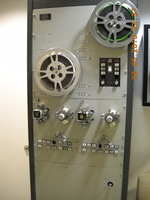 After all of the elements had been assembled onto separate reels and checkerboarded, the sound was ready for "re-recording", "mixdown", or "dubbing"--as the process was referred to. Although some people also think of foreign language replacement as "dubbing", that is not the correct usage of the term. In Hollywood, "dubbing" means mixdown--not A.D.R. and not language replacement.
After all of the elements had been assembled onto separate reels and checkerboarded, the sound was ready for "re-recording", "mixdown", or "dubbing"--as the process was referred to. Although some people also think of foreign language replacement as "dubbing", that is not the correct usage of the term. In Hollywood, "dubbing" means mixdown--not A.D.R. and not language replacement.
The first step was the "pre-dubs". This involved pre-mixing all of the individual checkerboarded tracks of each element down to just a few in number.
Since, on a major motion picture feature, there can easily be as many as sixty or seventy individual tracks for every one reel of picture (approx. 10 minutes worth), and ten or eleven reels of picture to a full length movie--we were talking about a truckload of sound stock! Today, all of those pallets of mag stock can fit onto one small hard drive.
On a smaller show, such as a documentary, there may be only several individual tracks.
Using a geometric (or pyramid) type progression, all of these reels are eventually mixed down to a manageable few. For instance, let's say there are 5 production dialogue reels, and 3 A.D.R. reels. Eight reels, just for Dialogue, is difficult for one set of hands to manage. But all of these tracks could be mixed down to just one or two Dialogue reels. Then we pre-mix the fifteen or so reels that make up only the ambient backgrounds, and pare those down to just two or three. Similarly, reduce forty or so sound effects and Foley reels to just three. And so on.
Today's style of mixing has evolved so that mixing consoles (or mixing software) supports the concept of "ghost faders". Physically (or virtually) the position of the faders are key framed. In other words, memorized by the computer as they are manipulated in real time. During a playback, the computer controls the up and down motion of the faders remotely, as if a player piano. The soundmixer is free to manually override the automated faders at any time to make slight corrections in the (programmed) mixdown.
The soundmixer still pre-mixes groups of elements same as in the old days of recording the pre-dubs. Only difference is that instead of recording the pre-dub to a fresh track and losing one generation of audio, the computer memorizes all of the settings in order to play everything together in one great symphony of individual soundtracks!
Now, we were ready for the final mixdown. No longer were there sixty reels, but perhaps nine. These nine, which now include Dialogue, Effects, Music, and Narration could now be mixed down to their final composite levels in relationship to each other.
However, in real life, the elements were not actually combined into one monaural track. Instead, they were mixed down to three monaural tracks--Dialogue, Music, & Effects--all on the same piece of sprocketed film (known as fullcoat or three-stripe). Producers kept these three elements separate in case they should ever later want to modify the finished film, such as by replacing the English dialogue with a foreign language, or updating the music to appeal to a different audience.
It is because of this eventual mix to a "DM & E" that editors strive to isolate as many effects as possible from the production dialogue tracks. That way, the dialogue can be replaced without having to replace all of the sync sound effects that would be lost with it.
On a stereo release, the mixers would end up with a DM & E for each stereo channel. Simple stereo would require two: Left, Right. Older 35mm stereo required four: Left, Center, Right, Surround. 70mm used six: Left, Center-Left, Center, Center-Right, Right, Surround.
Dolby Digital and D.T.S. requires six: Left, Center, Right, Left-Surround, Right-Surround, Sub-woofer. S.D.D.S. uses eight: Left, Left-Center, Center, Right-Center, Right, Left-Surround, Right-Surround, Sub-woofer. 5.1 of course refers to: left, center, right, left surround, right surround, and sub-woofer.